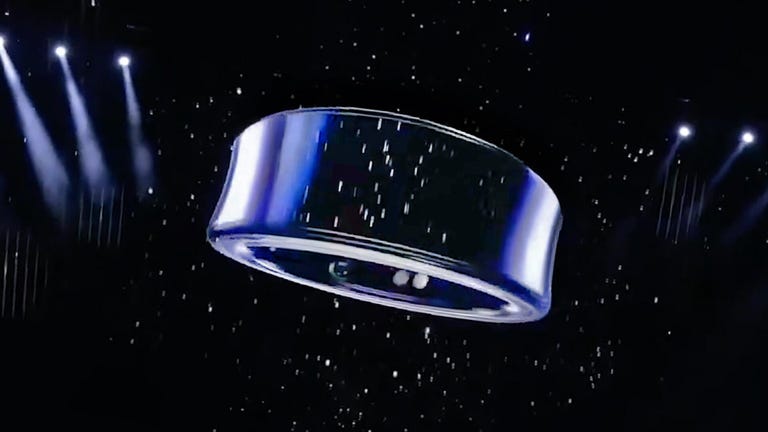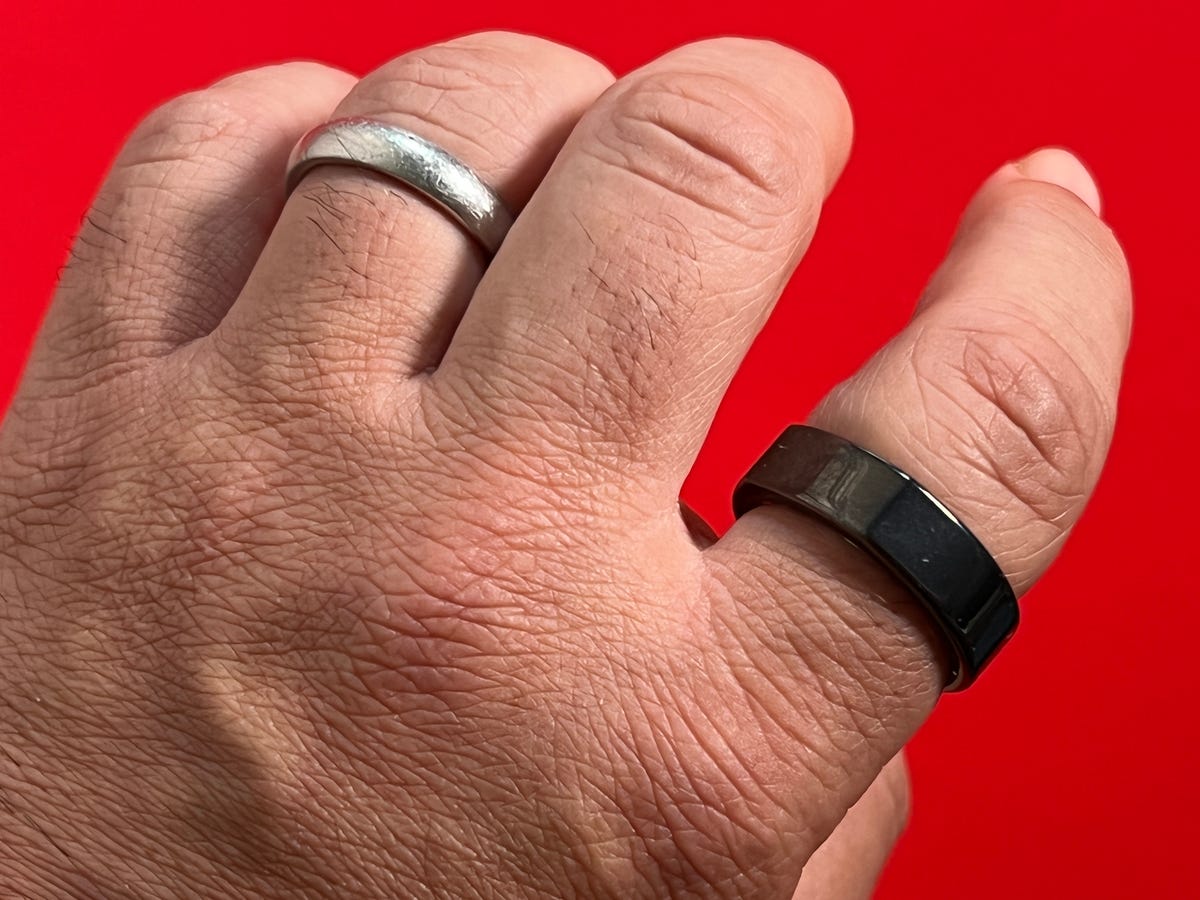At the end of its Unpacked event back in January, Samsung introduced its Galaxy Ring wearable as the next gadget in its mobile lineup. With no release date or price, the debut was little more than a tease that hints at Samsung’s plans for a new health and wellness product, leading us to wonder — who is the Galaxy Ring for?
To put it in the company’s words, the Galaxy Ring is another device in a network of wearables and phones that feeds data into the Samsung Health app. “I think you should look at the ring as one of many steps toward multi-device engagement,” Samsung VP and head of the digital health team for the mobile business Hon Pak told CNET’s Lisa Eadicicco.
Read more: Best Phone of 2024
So it’s another way to track the kinds of personal data that funnel into Samsung Health: sleep, nutrition, activity and stress. Specifically, it’s a product for someone who might not want a Galaxy Watch or other wrist-bound wearable but still want to monitor their own health, and may find a ring less cumbersome to wear.
“A ring can be less intrusive than a watch, and the finger provides a better physiological location for some health metrics than the wrist,” Avi Greengart, president and lead analyst at Techsponential, who also got a preview with Samsung’s Pak, told CNET.
Samsung expects that some consumers may want both a ring and a watch, while others will pick one or the other, Greengart said. Some may even pick up a ring because they like the look, which Eadicicco described as a sleek minimalist band that resembled a groom’s solid-metal ring (the sensors line the inside).
Samsung’s reveal of the Galaxy Ring at its Galaxy Unpacked event.
“Personally, I am very excited about this device because I’ve been looking at rings myself and I find that many are quite bulky and the Galaxy Ring might actually be perfect for me, especially since I already use a Galaxy Watch 6 classic,” said Anshel Sag, principal analyst at Moor Insights and Strategy.
Given a smartwatch’s display and suite of sensors, Sag doesn’t see people outright replacing them with fitness rings. Instead, they’ll fill the gaps to provide health data when watches aren’t worn, like when they’re charging overnight. Even better would be if the Galaxy Ring simply works without a lot of setup, and Sag thinks it probably won’t need a new app on Samsung phones and will neatly integrate with other health data.
While fans of smartwatches clamor for sharper, brighter displays to improve interactions, there’s another contingent of tech users who are content with devices that do everything quietly in the background. The Galaxy Ring could appeal to those who want to track their health data but don’t want another mini-phone gadget clamoring for their attention.

Watch this: Samsung Galaxy Ring: First Impressions
“The idea behind such rings is not so much about being cheaper than smartwatches, but instead being a much smaller and discrete device for use cases like sleep tracking,” said Bryan Ma, VP of devices research at International Data Corporation.
The Galaxy Ring could also be for a more limited group of people who want to track health using the company’s proprietary Samsung Health app but have an iPhone, and thus can’t connect to more modern Samsung wearables and watches. (The Galaxy Watch line has been Android-only since the company partnered with Google in 2021 to use Wear OS 3 software.)
Samsung hasn’t released pricing or given any indication how much the Galaxy Ring will cost, nor what kinds of health features it’ll offer compared to other health wearables. Thus, it’s hard to predict how the Galaxy Ring will distinguish itself and appeal to its core user base — but given the market, we can speculate about who will most want to sign up for Samsung’s next gadget.

The Oura ring on the right compared to a metal band on the left.
What the market has in store for the Galaxy Ring
The elephant in the room is that other health-tracking rings exist, most notably the Oura and Monavo’s Evie, which have been adopted by celebrities and athletes — but thus far haven’t gone widespread with the general public. It won’t be easy for Samsung to compete, but the company has advantages of scale and an existing ecosystem of other devices that should lend it flexibility, Forrester VP and Principal Analyst Julie Ask told CNET.
“Oura started out as hardware. Now they bundle in a subscription to pay for more insights,” said Ask. “Samsung could just sell the hardware… and at a lower price point than Oura is.”
Like any other gadget, price dictates adoption and people need more convincing to buy expensive products — especially those in a category that’s relatively new in the market. A Samsung Galaxy Watch 6 that starts at $300 is easy to compare to a $400 Apple Watch 9 or $450 Garmin Venu 2, but less easy to line up against the Oura ring, which starts at $300.
So what price Samsung sets for the Galaxy Ring matters, Ask said. If it’s $100 to $200, tech fans may be more willing to buy-and-try even if it ends up in a sock drawer after a few months. If it’s over $300, they’ll need to know its value before purchasing.
They be more convinced when they see it in action, and we expect to hear a lot more about the Galaxy Ring when Samsung gears up to launch it. But beyond price and tech specs, Samsung will have to prove that the Galaxy Ring is easy to use. Most people depend on an engagement strategy — think of those annoying but effective reminders to stand — that makes use of different motivations like gamification, competition, coaching, support and so on, Ask said.
Samsung confirmed that its Samsung Health app will get a new feature called Booster Cards, which give insight into your health readings. If your sleep score is low, a card might tell you it’s because you’re tossing and turning, for example.
Therein lies an opportunity for Samsung to grab a segment of consumers who care about their fitness and want a wearable that’s intuitive and easy to use — and that will more accurately deliver health info than the solutions we have right now.

Fitting in AI and gaining a foothold in the market
Since existing health ring wearables funnel collected health data to phones, and Samsung has been using its Samsung Health app on phones as a nexus for fitness and health metrics, it makes sense to expect the Galaxy Ring to do the same. The other question with Samsung’s new gadget is how it will benefit from advances in paired phones — which, in 2024, means generative AI.
The Samsung Galaxy S24 phones that launched in mid-January all feature generative AI capabilities, like Circle to Search and Generative Edit, all bundled into a package called Galaxy AI. With all the gen AI features announced in the Snapdragon 8 Gen 3 that powers the S24 series, it would make sense to have some of that functionality in the Samsung Health app and work with the data collected by the Galaxy Ring.
Read more: How Samsung’s Galaxy AI Features Stack Up Against Google and Apple
Again, Samsung’s tease of the Galaxy Ring was so sparse that there’s no way to glean any confirmation of generative AI features, or what impact it might have on the previously announced Galaxy AI features on the S24 series. But given Samsung’s investment in this area, it would make sense to leverage that with more data gathered by the Galaxy Ring.
“[The Galaxy Ring] should expand the market, whilst tying into the expanding AI device ecosystem,” Gartner analyst Ranjit Atwai told CNET.
And while Apple hasn’t announced AI health-tracking features yet, Google is gearing up to use AI-provided health insights in its Fitbit devices when it launches the Fitbit Labs feature later this year. AI may not just be a distinguishing feature for the Galaxy Ring, it might be the bare minimum it needs to keep up with the features coming in this year’s health wearables.
Samsung will need more than a smartwatch and ring to get a strong foothold in the fitness wearable category, Forrester’s Ask noted. They’ll need to educate people and build that market. That starts with convincing them of the usefulness of the Galaxy Ring.
“They will need an outstanding digital experience that makes set up easy, offers amazing insights, and one that drives effective engagement with consumers,” Ask said. “[That’s] hard to do.”

